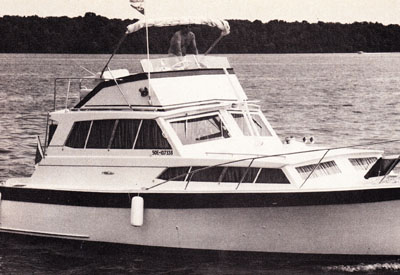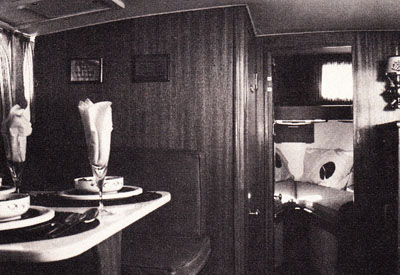Pacemaker 34
By Fraser Munro
After spending a great deal of time in the bilge with a bright light and an ice pick, I found the Pacemaker to be sound. It needed some hard work, tender care and tasteful decoration, but most important, it was a solid boat.
It was a cool, rainy Easter weekend in the spring of 1981 when my wife, Wendy, and I traveled to the northern sunshine city of Orillia. We had been looking for a powerboat, specifically a cruiser; for more than a year.
We had looked at all shapes and sizes, big and small, affordable and unaffordable. Though we hadn’t found the boat of our dreams, we had made an important decision: we wanted a Pacemaker. In our exhaustive search, we hadn’t come across another wooden cruiser with as much interior space for its overall length.
Finally; we were on our way to see a 1970 Pacemaker 34, full of anticipation that this was the yacht we sought.
This Pacemaker; a convertible sedan six-sleeper; had been used for fishing. While the previous owners had had the sense to protect the exterior from the elements, the last paint job had been executed with three gallons of white marine paint and a mop. The interior was untouched, but cried out for a cosmetic makeover.
Despite its surface shabbiness, there was no doubt this boat was designed for comfort. The saloon was larger than any comparable 34- or 36-foot cruiser we had been on, and the interior mahogany was in excellent shape, adding a feeling of warmth to that cool, wet April day. My first concern, however; was to make sure the boat was sound.
Pacemakers have conventionally been built on a semi-displacement hull. Each solid oak rib and each hull plank has been carefully engineered and painstakingly formed to produce one of the strongest wooden hulls ever manufactured.
The single-planked hull of a Pacemaker was made of the finest 7/8-in. Philippine mahogany money could buy. Its carvel planking is fastened with silicon bronze screws. The transom is double-planked marine mahogany plywood outside, over 3/8-in. plywood inside – both attached to the heavy oak framework.
 The cockpit and saloon floors are constructed of pressure-treated ¾ in. fir plywood; the cockpit is covered with white Nautolex.
The cockpit and saloon floors are constructed of pressure-treated ¾ in. fir plywood; the cockpit is covered with white Nautolex.
After spending a great deal of time in the bilge with a bright light and an ice pack, I decided that although I had some exterior work to tackle, some of it hard work, I had a basically sound boat.
A couple of hours had slipped by when we both spotted another 34-foot Pacemaker in the water. The temptation to explore a second 34, this one a 1967 edition in mint-condition, was too great to ignore. Graciously, the owner permitted us to insect his pride and joy.
Again, we had the distinct impression of warmth on entering the main saloon. This time it was the warmth of cabin heaters, which gave a cozy, comfortable atmosphere on a very damp day. Heaters are supplied in the main saloon and the galley/dinette area. On newer models, Pacemaker has also added a heater in the V berth.
The richness of the imported Philippines mahogany found on all Pacemakers had been tastefully highlighted by beige and brown tweed drapes throughout the boat. Rust coloured broadloom, a couch and easy chair added to the atmosphere of warmth and comfort. We have since found out that owners don’t settle for glorified camping in their Pacemakers; they are truly homes away from home.
Our two inspections had left us undeniably smitten. The Pacemaker 34 would be ours. I tracked down Crate’s Marina’s owner, Brian Crate, to work out the details. He offered to paint the hull and replace any soft wood in the boat. We were fortunate; despite the boat’s neglect over the years, our transom was sound, though the gunwales had to be replaced. Both are typical problems in Pacemakers that have lacked cosmetic care for any length of time. By the middle of June, the exterior was refurbished, we were in the water and had started our cruising adventure.
Wendy had replaced all the drapes with a blue-beige tweed material. I had replaced the broadloom with a deep, royal blue pile. We purchased a bed/chesterfield for the saloon, added a few nautical decorations and we were satisfied with our new summer home.
One thing we both enjoy about our Pacemaker is the galley. It is pie-shaped and recessed into the starboard side, giving the galley/dinette area an airy feeling. A 10-cubic-foot refrigerator/freezer accommodates all the food we or our guests could consume in a week.
 Earlier 34s generally came with a standard two-burner alcohol stove, but most have been replaced by electric elements. Our 1970 Pacemaker has a three-burner Princess oven, considered standard equipment in later years. An exhaust fan is located above the stove, which allows cooking even on extremely warm days.
Earlier 34s generally came with a standard two-burner alcohol stove, but most have been replaced by electric elements. Our 1970 Pacemaker has a three-burner Princess oven, considered standard equipment in later years. An exhaust fan is located above the stove, which allows cooking even on extremely warm days.
A large stainless steel sink with a modem single faucet which supplies both hot and cold pressure water is situated in the center of the galley, surrounded by ample counter space.
Storage space abounds. Five drawers are built into the galley cabinet; there are two large cupboards under the sink and three large drawers under the dinette. Space under the stairs is also used for storage.
The dinette converts to a double berth, which can sleep two adults comfortably. Doors between the saloon and galley can be closed and latched, enclosing the entire center cabin for security and some added privacy.
The enclosed head includes a large vanity and shower; again with ample storage space. Two doors leading from the head allow access forward into the V berth or aft to the dinette area.
The V berth, which has standing headroom of 6 ft, 2lh in., will accommodate two adults quite comfortably.
Three wardrobe lockers serve the main saloon, dinette/galley and V berth areas.
The flying bridge was not included as part of the base price for the standard boat, but was considered an option. However; most of the 34s (including ours) were purchased with the spacious bridge. It will accommodate four adults sitting, with room to spare. I raised the position of the bridge instruments from their very low placement so that I would have a clear view of all the gauges at all times. It made an excellent winter project.
Access to the bridge is extremely good. Hatches are conveniently placed throughout the boat for easy admission to all pertinent areas. Engine access is first rate, with two folding hatches over each engine and a center hatch between for easy maintenance. Battery packs, water heater; engine sea cocks and main electrics are all located under this center hatch.
Our Pacemaker also features a 4 kw generator: Once standard equipment, the generator is now a $3,500 to $5,000 option.
With all this equipment we find ourselves completely and totally self-sufficient, wherever we want to go. Rarely in a hurry to reach our destination, we generally travel at a slow cruise. At 1,500 rpm we will move at around 12 mph. Our 34 Pacemaker is equipped with twin 260-hp Crusader engines which can propel us along at a comfortable cruising speed of 18 mph and still remain economical, an asset when running from weather; or reducing the tedium during long passages, or for the sheer fun of it over open water: It’s easy to forget we’re pushing 14,000 lbs on a semi-displacement hull; at 4,000 rpm we realize 24 mph!
We are pleased at how well the Pacemaker rides in rough seas. The 34 will cut through a head-on sea, in fairly choppy or rolling water; like a warm knife through butter: There is no hard pounding, and with spray surrounding the bow, it can be an exciting, safe and comfortable cruise. The boat’s only drawback is its soft chine which in a tendency to roll or, in a heavy following sea, to broach.
Pacemakers were designed primarily for saltwater operation and infrequent hauling. Taking the boat from its natural habitat and letting it hang to dry for six months in our dry, cold winters extracts every drop of moisture from its hull. Thus, come spring, the Pacemaker at launch time will be found hanging in its slings, soaking.
Standard equipment in the most recent wooden Pacemakers includes: enclosed head with hot and cold pressure water system, shower and shower pump; galley with 10-cubic-foot 110-volt electric refrigerator; dish and glass racks and Formica counter top; eight-gallon hot water heater; 50 gallon stainless steel freshwater tank; pilothouse; 12-volt light fixtures in the forward bunks, dinette, galley and head; circuit breaker or fuses; generator; and two 75-gallon Monel fuel tanks.
Would I purchase another Pacemaker? After careful consideration I have become typical of most boat owners. Of course I would; I’d like a larger one!
Originally published in Canadian Yachting’s May 1983 issue.
Pacemaker 34 Convertible Sedan Six-Sleeper
Specifications
LOA: 34 ft
Beam: 11 ft 10 in.
Draft: 2 ft 6 in.
Displacement (dry):13,095 lbs
Height above waterline to top of flybridge: 11 ft 10 in.
Bridge: 42 sq.ft.
Fuel Capacity: 150 gal.
Water Capacity: 50 gal.
Hot water: 12 gal.
Holding tank:35 gal.
Head type: Crown
Refrigerator/freezer: General Electric 10 Cubic ft., 110-volt
Stove: Optimus Princess 3-burner plus oven
Mechanical
Engine: Recommended – Twin 180-220 hp
(test boat has crusader twin 260 hp)
Steering: Cable
Propeller:23-in., 4-blade, bronze
Range:300 miles at “ecocruise”
Approximate current market value (1983): 35,000
Photo Captions
Photo 1 – A powerboat built to last.
Photo 2 – The spacious bridge was an option on early boats but most 34s were purchased with a bridge.
Photo 3 – A salon with interior helm station leads to the dinette area.























